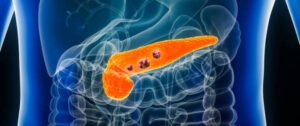
6 Major Symptoms of Thyroid Cancer! Understand the Causes, Types and Treatments of Thyroid Tumors
The incidence rate of thyroid cancer has gradually increased in recent years, and the incidence rate of female patients is more than three times that of male patients. It ranks fourth among the top 10 most common cancers in women. What are the precursors of thyroid cancer? What are the causes of thyroid cancer? What symptoms will occur? We get to know you deeply and fight thyroid cancer together!
What is thyroid cancer? Thyroid location explained
The thyroid gland is the largest endocrine gland in the human body. It is shaped like a butterfly and covers the front of the trachea in the neck. It is divided into left and right lobes, connected by an isthmus in the middle. The average length is about 2.5~4 cm and the width is 1.5~2 cm. It is used for secretion Thyroid hormone controls the metabolism of the whole body and affects changes in blood pressure, heartbeat, body temperature and weight. Thyroid cancer occurs when normal cells in the thyroid gland become abnormal and grow out of control.
6 major symptoms of thyroid cancer
The following are the 6 most common precursors of thyroid cancer. If you find yourself experiencing the following symptoms, please seek medical examination as soon as possible for early detection and early treatment:
- A lump appears in the neck
- Hoarseness
- Persistent sore throat
- Hard to swallow
- Prolonged cough that does not heal
- Having trouble breathing

There are 4 types of thyroid tumors
- Papillary thyroid cancer
Papillary cancer is most common in those aged 30 to 45 years. It is the most common type of thyroid cancer and has the best prognosis. About 80% of thyroid cancer patients have papillary cancer. Papillary cancer is caused by lesions of thyroid follicular epithelial cells and is prone to occur in patients with excessive iodine intake. Because tumors grow slowly and usually stay localized for several years, it can easily lead to patient neglect. Nearly 30% of patients have cervical lymph node metastasis at the time of diagnosis, but distant metastasis is less likely to occur, so the survival rate of patients is higher. - Follicular thyroid cancer
Follicular cancer is common in patients aged about 40 to 50 years old. Its incidence is second only to papillary cancer and accounts for 15% of thyroid cancer. Like papillary cancer, it is caused by thyroid follicular epithelial cell lesions and is prone to occur in patients whose daily diet is deficient in iodine. Tumors often metastasize to organs such as the lungs or liver through blood flow, and are less likely to metastasize to local lymph nodes. situation. - Medullary thyroid cancer
Medullary cancer is more common in women over 40 years old and accounts for about 3% of thyroid cancers. Medullary cancer is mainly caused by the canceration of parafollicular C cells into malignant tumors. Its tumor malignancy is higher than the above two types of thyroid cancer. It can not only metastasize to other parts of the gland or local lymph nodes through thyroid endolymph, but also can It is transferred to distant organs through blood flow, such as lungs, bones and liver. - Anaplastic thyroid cancer
Anaplastic cancer tends to occur in elderly people over 60 years old. Most patients have thyroid nodules for many years; or they have had well-differentiated thyroid cancer (especially papillary cancer), which may develop through the degeneration of the original thyroid cancer cells. into undifferentiated carcinoma.
Anaplastic cancer accounts for only 1% of thyroid patients. Because the condition often deteriorates rapidly, when the cancer is discovered, it is usually impossible to eradicate it with surgery. Moreover, patients do not respond well to chemotherapy and radiotherapy, so the prognosis of treatment is extremely poor. , the patient’s survival rate generally does not exceed 2 years.
Thyroid cancer causes?
The causes of thyroid cancer are complex. Currently, academic circles believe that people who meet any of the following conditions have a higher risk of developing thyroid cancer:
- Those who have received head and neck radiation therapy (600-2000 cGY): Children or adolescents who have received head and neck radiation therapy have a higher risk of developing benign thyroid lesions or thyroid cancer within 20 years.
- Family inheritance: About 1/4 of medullary thyroid cancers have a family inheritance tendency.
- Hashimoto’s Thyroiditis:
A type of chronic thyroiditis, the disease will cause the body’s immune system to become imbalanced and produce thyroid antibodies, allowing the immune system to attack the thyroid gland, resulting in hypothyroidism and symptoms such as diffuse moderate enlargement of the thyroid gland. A small number of patients with Hashimoto’s thyroiditis may be associated with the development of thyroid lymphoma.
Thyroid cancer screening and diagnosis
- Blood test:
Through blood test, you can first determine whether there is any abnormality in thyroid function, and then make further diagnosis. - Thyroid ultrasound:
It can measure the size and number of thyroid nodules, determine whether the nodules are malignant, and evaluate the need for fine-needle aspiration cytology. - Fine needle aspiration cytology:
Use a hollow needle to aspirate cells from thyroid nodules or thyroid tissue with suspected lesions, place them on a slide for staining, and then perform the examination. This method does not require any anesthesia and is the easiest way to diagnose thyroid cancer. and effective method.

4 treatments for thyroid cancer
- Thyroidectomy
The most important way to treat thyroid cancer is to remove part or all of the thyroid gland. Types include partial thyroidectomy, unilateral thyroidectomy, near-total thyroidectomy, total thyroidectomy, etc. The patient undergoes surgery under general anesthesia. Patients who undergo total thyroidectomy must take thyroxine for life. - Radioactive iodine (I-131) treatment
After thyroidectomy, more than 90% of patients with thyroid cancer may still have residual tissue in their bodies. Therefore, doctors will take advantage of the ability of thyroid cancer cells to absorb iodine and use radiation to kill thyroid cancer cells as a surgical procedure. adjuvant treatment. - External beam radiation therapy
It can be used to remove thyroid cancer cells remaining after surgery, and can also be used in patients with extremely malignant anaplastic cancer. It is almost unresponsive to radioactive iodine treatment. Doctors often use external radiation therapy to destroy cancer tissue to slow the growth of cancer cells and relieve patient pain, but it cannot cure cancer. - Targeted therapy
Targeted drugs such as Nexar and Lenvima can be used to treat localized or metastatic thyroid cancer that is poorly responsive to radioactive iodine.

Take appropriate amounts of iodine! 4 ways to prevent thyroid cancer
To prevent thyroid cancer, it is recommended that the public should refer to the following suggestions and adjust their lifestyle to reduce the risk of cancer:
- Get the right amount of iodine
Iodine is a trace mineral needed by the human body. The iodine contained in food will be absorbed through the intestines after consumption, and then concentrated by the thyroid gland through blood circulation, converting inorganic iodine into organic iodine, and finally mixed with thyroglobulin combine. When iodine intake is insufficient, the pituitary gland secretes thyroid hormone to increase, affecting thyroid function. When iodine intake is excessive, normal people can excrete it through urine. However, some people have excessive iodine intake for a long time, which suppresses the thyroid gland, leading to Enlargement of the thyroid gland. Therefore, you should take in an appropriate amount of iodine at ordinary times, and the recommended daily intake of iodine for adults is 140 micrograms. You should also avoid eating foods with high iodine content such as seaweed, seaweed, kelp, and jellyfish. - Eat less hot food:
Chew your meals slowly and let hot meals cool before eating to avoid thyroid damage. The most suitable eating temperature for the human body is 10~40℃. Once it exceeds 65℃, it will burn the oral and esophageal mucosa, increasing the risk of esophagitis, thyroiditis and esophageal cancer. - Relax
Being depressed or irritable for a long time can easily lead to neurological disorders, endocrine disorders, and thyroid-related diseases. Therefore, you may wish to engage in some moderate leisure activities during normal times to relax and relieve inner stress at the right time. - Avoid staying up late
Staying up late can weaken the function of the thyroid gland and increase the risk of thyroid cancer. Especially those with poor thyroid function should reduce the number of late nights to prevent thyroid cancer from finding you.












